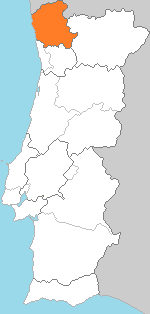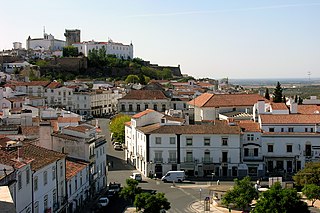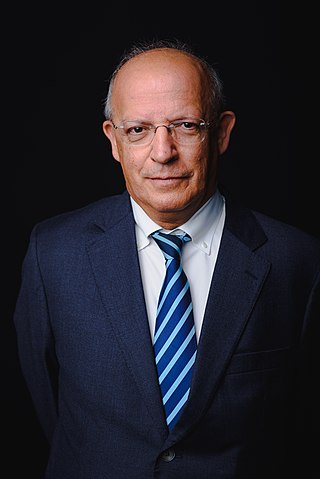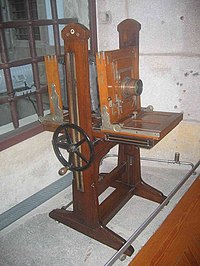
Calves is a hamlet in Póvoa de Varzim, Portugal. It is divided between the parishes of Argivai and Beiriz and in the 2001 census it had 138 inhabitants.

Minho was a former province in Portugal, established in 1936 and dissolved in 1976. It consisted of 23 municipalities, with its capital in the city of Braga. Today, the area would include the districts of Braga and Viana do Castelo. Minho has substantial Celtic influences and shares many cultural traits with neighbouring Galicia, in northwestern Spain. The region was part of the Roman Province and early Germanic medieval Kingdom of Gallaecia. Historical remains of Celtic Minho include Briteiros Iron Age Hillfort, the largest Gallaecian native stronghold in the Entre Douro e Minho region, in north Portugal. The University of Minho, founded in 1973, takes its name from the former province.

Rio de Contas is a municipality in the Bahia state, in the eastern part of Brazil. Its estimated population as of 2020 was 12,932.
The Monastery of the Mónicas, located in São Vicente, Lisbon, was a Portuguese nunnery dedicated to the mother of Augustine of Hippo, Saint Monica. It later became a prison.
Leandro Vilas Boas Simioni, also known as Leandro Testa, is a Brazilian former professional footballer. In December 2010 Simioni was involved in a car accident in Brazil, he was seriously injured and left paralyzed from the waist down.

Desembargador is a Portuguese title given to some appellate judges in Portugal, Brazil and other countries influenced by the Portuguese legal tradition.

The Image Museum or in Portuguese Museu da Imagem is located in Braga, Portugal and is dedicated to photography.

Estremoz is a municipality in Portugal. The population in 2011 was 14,318, in an area of 513.80 km2. The city Estremoz itself had a population of 7,682 in 2001. It is located in the Alentejo region.

The Residence Rua D. Hugo is a residence and archaeological site in the civil parish of Cedofeita, Santo Ildefonso, Sé, Miragaia, São Nicolau e Vitória, in the municipality of Porto, in the Portuguese district of Porto.

The Trindade hotspot is a working hypothesis supposing that the submarine volcanic chain Vitória-Trindade, off the eastern coast of Brazil in the southern Atlantic Ocean, is a volcanic hotspot chain. It was considered that the supposed hot-spot should be responsible for the creation of the east-west trending Vitória-Trindade seamount chain, which includes the Trindade and Martim Vaz archipelago at its easternmost end. Trindade, a small island in the archipelago, is the hotspot's most recent eruptive center.

Igreja de Santa Clara is a Catholic church located in the parish of Sé in Porto, Portugal.

Augusto Ernesto dos Santos Silva is a Portuguese sociologist, university professor, and politician who served as the President of the Assembly of the Republic between 2022 and 2024, in the 15th Legislature. From November 2015 to March 2022, he was the Portuguese Minister of Foreign Affairs, in the XXI and XXII Constitutional Governments led by Prime Minister António Costa.

The Old Cathedral of the Holy Name of Jesus also called Holy Name of Jesus Cathedral is the former headquarters of the diocese of Bragança-Miranda in northeastern Portugal. The temple was built in the sixteenth century to have the functions of a convent. In 1764, with the transfer of the seat of the diocese of Braganza Miranda do Douro, the building became the diocesan cathedral. With the opening of the new cathedral in 2001, the church became a parish church.
The following is a timeline of the history of the city of Porto, Portugal.

The Museum of the History of Catalonia is a history museum in Barcelona that promotes the awareness and knowledge of the history of Catalonia and its culture. The museum is located in Barcelona's Palau de Mar, the former General Stores, the sole building of Barcelona's old industrial port still standing.

The Tiradentes Palace is an eclectic government building located in the Centro neighborhood (bairro), next to the Paço Imperial in Rio de Janeiro, Brazil. It was inaugurated on 6 May 1926 and was the former seat of the Chamber of Deputies of Brazil, between 1926 and 1960, and is the current seat of the Legislative Assembly of the State of Rio de Janeiro.

Fort São Neutel is located in the Parish of Santa Maria Maior of the city of Chaves, District of Vila Real, in Portugal.















